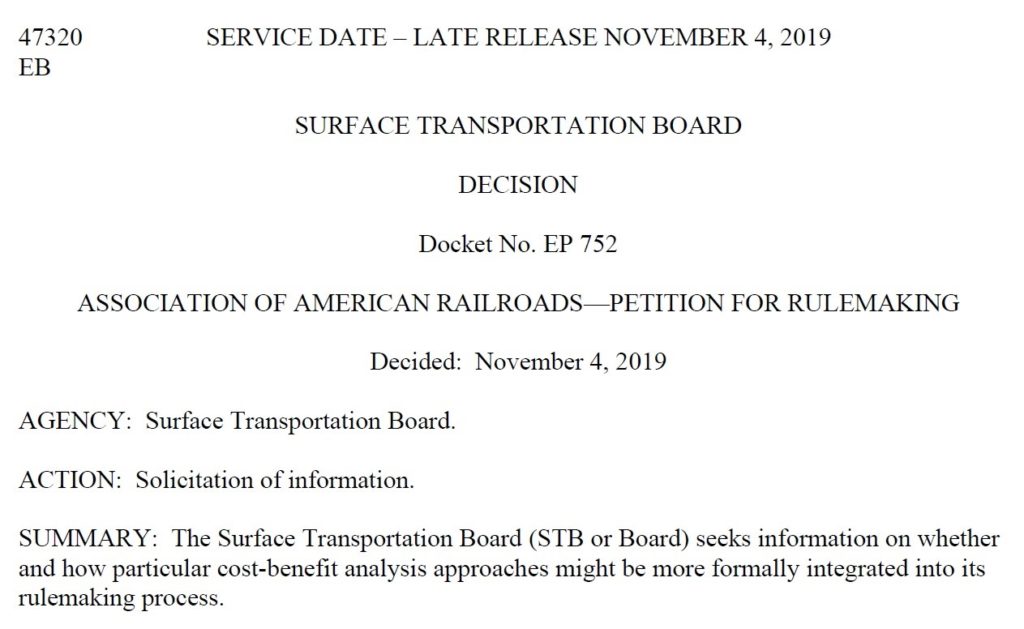Week in Regulation
November 12, 2019
A Busy, Costly Week
The first full week of November was a relatively active one on the regulatory front. Federal agencies produced 18 rulemakings that had some sort of quantifiable cost or savings estimate. While there were some notable cost-reducing measures, there was one health care rule that brought billions in new costs. Across all rulemakings, agencies published $867.7 million in total net costs and added nearly 2.5 million hours of annual paperwork.
REGULATORY TOPLINES
- New Proposed Rules: 44
- New Final Rules: 58
- 2019 Total Pages: 60,775
- 2019 Final Rule Costs: $25.3 Billion
- 2019 Proposed Rule Costs: -$5.1 Billion
TRACKING THE REGULATORY BUDGET
The most notable rule that impacts the fiscal year (FY) 2020 regulatory budget under Executive Order (EO) 13,771 was a regulatory action from the Department of Health & Human Services (HHS). The rule makes a variety of changes to Medicare and Medicaid’s “home health prospective payment system” for calendar year 2020. HHS estimates that the administrative burdens imposed in the implementation of these changes comes out to nearly $170 million annually, or roughly $2.4 billion in net present value. This makes it the early leader in the FY 2020 regulatory budget clubhouse for costliest regulatory action.
The most notable deregulatory action of the week came from the Internal Revenue Service (IRS). This rule focuses upon the “Removal of Section 385 Documentation Regulations.” The removal of these requirements also removes certain administrative burdens for affected parties. IRS estimates that, over a 10-year window, such a shift opens up $685 million in savings “by eliminating the need to document relevant transactions in a prescribed manner.”
For FY 2020, agencies have finalized 20 deregulatory actions and four regulatory actions, totaling $1.4 billion in quantified total net costs. The Trump Administration has yet to release its regulatory budget goal for FY 2020, though it is expected soon.
THIS WEEK’S REGULATORY PICTURE
This week, an independent agency considers cost-benefit analysis (CBA).

Executive agencies are required to consider costs and benefits of their significant regulatory actions under Executive Order 12,866. This requirement, however, does not extend to independent agencies. Some independent agencies have moved to require CBA when developing regulations, most notably the Federal Communications Commission.
This week, another independent agency took a small, but necessary, step toward adopting a CBA requirement. The Surface Transportation Board (STB), an independent agency that is the economic regulator of the railroad industry, issued a solicitation of information (SOI) concerning CBA.
The SOI relates to a petition for rulemaking filed in March by the Association of American Railroads asking the STB to adopt regulations requiring the Board to “incorporate meaningful cost-benefit analysis into its rulemaking proceedings and require the Board’s decisions to be informed by the most up-to-date and reliable information available.”
The STB takes a unique approach in the SOI. In addition to seeking recommendations on what specific methods and data the Board should consider in adopting a CBA requirement, it asks for a “detailed description” of how CBA would be administered in a hypothetical rulemaking where a revenue-cost percentage of 180 percent is modified to 165 percent. Essentially, the STB wants commenters to show how CBA could be utilized in such a scenario.
Despite the hypothetical, it is difficult to argue that STB’s decisions would not benefit from CBA, as AAF has explained. Economic regulation of this sort is suited to CBA because, particularly in the STB’s case, the stakeholders are likely to have the information at hand to present to the Board. Comments to the SOI are due by January 17, 2020, and replies to those comments are due by March 6, 2020.
TOTAL BURDENS
Since January 1, the federal government has published $20.1 billion in total net costs (with $25.3 billion in finalized costs) and 50.6 million hours of net annual paperwork burden increases (with 46 million coming from final rules). Click here for the latest Reg Rodeo findings.












